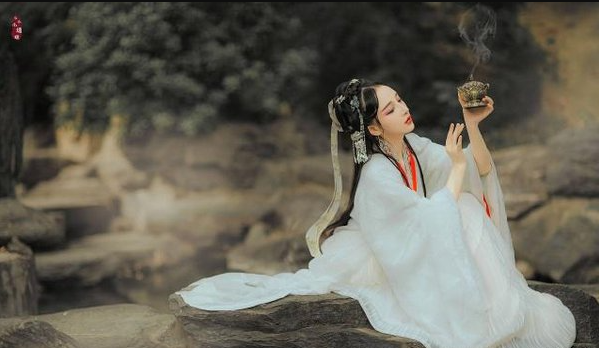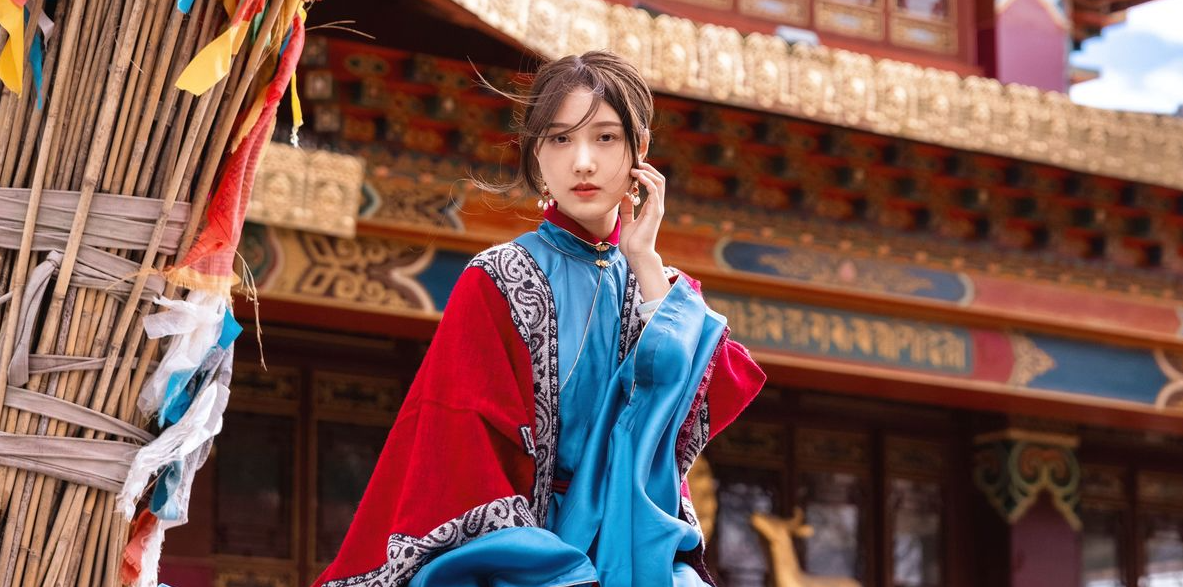Hanfu has surged in popularity due to its deep cultural roots, aesthetic appeal, and adoption by social media and celebrities.
Cultural Significance
The Hanfu as a Symbol of Cultural Identity
The Hanfu isn’t just a piece of clothing; it serves as a vivid symbol of cultural identity for many Chinese people. The dress’s intricate patterns, flowing fabrics, and unique cut echo a history that spans thousands of years. Whether one traces back to the Han Dynasty or even earlier periods, wearing Hanfu is a powerful way to connect with the past and affirm one’s sense of belonging to a rich cultural tapestry. Moreover, as China increasingly asserts itself on the global stage, the Hanfu has evolved into a form of “soft power,” offering a non-verbal expression of Chinese culture and sophistication. Wikipedia: Soft Power

How Hanfu Reflects Traditional Chinese Values and Philosophies
At its core, the Hanfu encapsulates more than just fashion; it is a sartorial representation of traditional Chinese values and philosophies such as Confucianism, Taoism, and even elements of Buddhism. The simplicity and elegance of the design reflect Confucian ideals of propriety and ritual. The flowing nature of the fabrics corresponds with Taoist principles of harmony and balance. Additionally, the choice of colors often follows the principles of Feng Shui and the five elements theory, further grounding the Hanfu in traditional Chinese thought. By wearing Hanfu, people are not just making a fashion statement; they are embodying centuries of Chinese wisdom and philosophy. Wikipedia: Traditional Chinese philosophy
Fashion and Aesthetics
The Unique Elements that Make Up Hanfu Design
Hanfu design captivates through a combination of form, function, and symbolism. The apparel often uses high-quality natural fabrics like silk, linen, and cotton, showcasing China’s long-standing expertise in textile production. Patterns and motifs are not chosen at random; they frequently feature elements like dragons, phoenixes, and floral designs that have specific cultural connotations. Layers are another essential element of Hanfu. They not only add depth and complexity but also offer versatility, allowing wearers to adapt to different social situations and weather conditions. The cut of the Hanfu, with its flowing lines and generous sleeves, gives room for movement and an ethereal grace, embracing the wearer in a visual narrative that tells stories of ancient heroes and timeless values. Wikipedia: Hanfu
Why Hanfu Is Considered Aesthetically Pleasing
Hanfu resonates with people not just for its cultural significance but also for its inherent beauty. The garments are visually striking, often employing a rich palette of colors ranging from subdued pastels to vibrant hues. The emphasis on symmetry and proportion in Hanfu design aligns with traditional Chinese artistic principles, offering a balanced and harmonious visual experience. The elaborate embroidery and fabric detailing work in concert to produce garments that are more than just clothes—they are pieces of wearable art. The elegance and balance intrinsic to Hanfu make it universally pleasing to the eye, crossing borders and cultural boundaries. Wikipedia: Chinese art
Social Media and Pop Culture Influence
The Role of Social Media Platforms in Hanfu’s Popularity
Social media platforms like Weibo, TikTok, and Instagram play a pivotal role in skyrocketing Hanfu into mainstream consciousness. Not only do they offer a space for Hanfu enthusiasts to share their outfits and styling tips, but they also act as platforms for educational content about the history and significance of the garments. Viral videos and posts showcase how to wear Hanfu, how to differentiate between styles, and even how to incorporate Hanfu into modern fashion. The use of hashtags like #HanfuMovement makes it easier for people to find and contribute to these virtual communities. Through social media, Hanfu has transcended geographical boundaries, drawing fans and followers from across the globe. Wikipedia: Social media
Celebrities Endorsing Hanfu
Public figures and celebrities have added fuel to the Hanfu movement’s fire. From film stars donning Hanfu at red carpet events to singers incorporating traditional garments into their stage outfits, the visibility is immense. Celebrities like Fan Bingbing and Kris Wu have been photographed in Hanfu, and their large fan following quickly takes note. These endorsements offer a level of legitimacy and modernity to the Hanfu, making it appealing not just as a historical garment but as a current fashion statement as well. Wikipedia: Celebrity endorsement
The Youth Movement
Why Young People Are Particularly Attracted to Hanfu
For many young people, Hanfu isn’t just an article of clothing; it’s a statement. It allows them to assert their individuality while connecting with their cultural roots. In a globalized world where Western fashion often dominates, the allure of Hanfu gives younger generations a distinct way to stand out. Additionally, the garment offers a creative outlet, with various styles, patterns, and customization possibilities, making each Hanfu uniquely individual. The experience of wearing Hanfu transcends the material to become an intimate expression of personal identity. Wikipedia: Youth subculture
Hanfu in University Campuses and Youth Events
University campuses have become hotbeds for Hanfu culture. It’s not uncommon to see students sporting Hanfu in cultural festivals, history classes, or even as everyday attire. This trend extends to youth events beyond the academic setting, including pop culture conventions and traditional festivals. Some universities even have Hanfu clubs, offering a space for enthusiasts to share, exchange, and celebrate this rich cultural heritage. Events like Hanfu fashion shows or Hanfu-themed balls create a sense of community among young people, making it more than just a fad but a social movement. Wikipedia: University culture
Festivals and Events
Traditional Chinese Festivals Where Hanfu Is Commonly Worn
Hanfu serves as the preferred attire for many traditional Chinese festivals such as the Lunar New Year, Mid-Autumn Festival, and Dragon Boat Festival. During these occasions, the wearing of Hanfu goes beyond mere fashion; it’s a practice steeped in ritual and symbolism. For example, bright red Hanfu are popular during the Lunar New Year as the color signifies good fortune and joy. At the Mid-Autumn Festival, people often opt for Hanfu featuring celestial motifs to resonate with the moon-centric celebration. Wikipedia: Traditional Chinese holidays
Modern Events and Conventions Focused on Hanfu Culture
Besides traditional festivals, modern events like Hanfu conventions, workshops, and fashion shows are increasingly incorporating Hanfu culture. These events offer a platform for enthusiasts to come together to showcase their Hanfu collections, participate in styling competitions, and even attend lectures on Hanfu history. Businesses and artisans use these events to showcase their latest designs and products, ranging from traditional styles to modern interpretations. Wikipedia: Fandom
Hanfu in the Global Context
How Hanfu Is Received and Adapted in Other Cultures
The influence of Hanfu isn’t limited to China; it’s making its mark globally. From high fashion runways in Paris to cultural festivals in New York, Hanfu is gaining international attention and acceptance. Designers from various countries are incorporating Hanfu elements into their collections, blending traditional Chinese aesthetics with local styles. The reception has been largely positive, often cited as a refreshing departure from mainstream fashion norms. In cosplay communities, Hanfu has also found a dedicated following, where people from different cultural backgrounds celebrate its beauty and intricacy. Wikipedia: Cosplay

The Role of Hanfu in Promoting Chinese Culture Abroad
Hanfu serves as a cultural ambassador in many respects. Exhibitions, cultural exchange programs, and fashion shows featuring Hanfu provide an opportunity for people worldwide to engage with Chinese culture on a tactile and visual level. Educational institutions abroad are using Hanfu as part of their curriculum to teach about Chinese history and traditions. Tourism boards and Chinese cultural centers are also utilizing Hanfu to offer a more in-depth and authentic experience of Chinese culture to foreigners. Wikipedia: Cultural diplomacy